Exploring Dubai's Abra Boat Service: A Detailed Guide
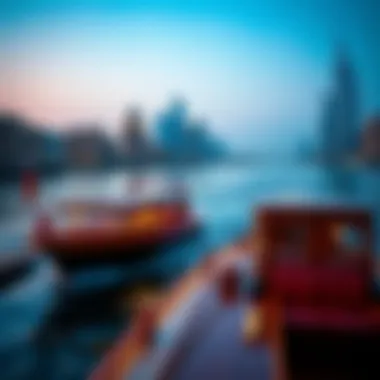
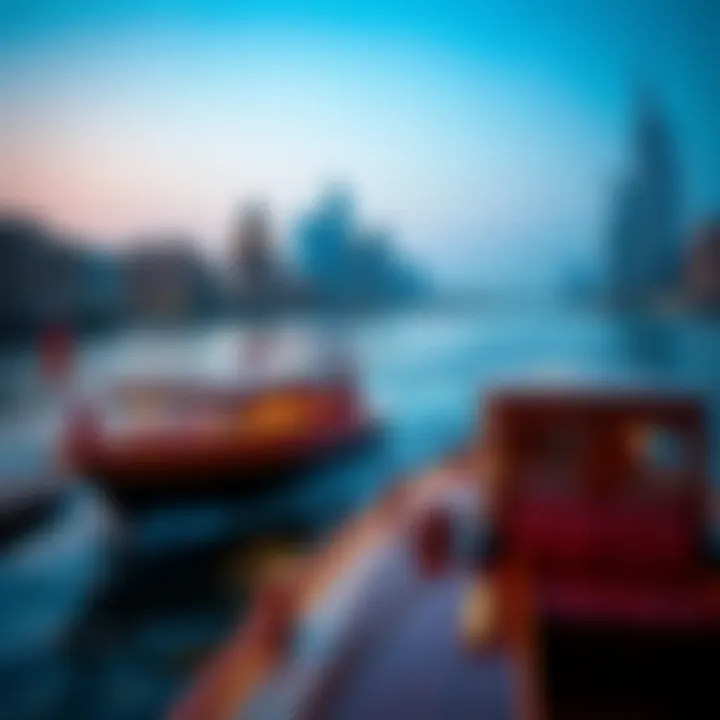
Intro
Dubai’s vibrant waterways have long been an essential part of the city’s identity, with the Abra Boat Service standing out as a historical pillar and a contemporary necessity. For both investors in real estate and lifestyle enthusiasts, understanding the mechanics and cultural significance of this service is more than just a casual interest; it serves as a vital cog in the intricate machinery of Dubai’s urban landscape.
As the hustle and bustle of the city unfolds, the gentle sway of the Abra boats invites one to explore the heritage of the region while navigating its modern transformations. This article will delve into the ins and outs of the Abra Boat Service, illustrating not only its operational nuances but also the broader implications for real estate investment and lifestyle choices within the emirate.
Market Insights
In recent years, Dubai’s real estate market has been dynamic, marked by shifts that reflect both global economic conditions and local developments. With the Abra Boat Service providing convenient access across key areas, it has become pivotal in shaping market trends.
Current Trends in Dubai Real Estate
Current trends indicate a growing interest in properties that offer proximity to waterfronts and easy access to transportation nodes like the Abra. Here are a few observations:
- Waterfront Properties: There’s a rising demand for properties along Dubai Creek, where the historic charm meets modern luxury.
- Mixed-Use Developments: Investors are increasingly looking for mixed-use properties that combine commercial and residential elements, fostering a community-centric lifestyle.
- Sustainability: As climate concerns mount, eco-friendly developments near water bodies are gaining traction, appealing to a new wave of investors interested in sustainable living solutions.
Understanding these trends not only helps buyers and sellers navigate the market but also highlights the importance of accessibility provided by services such as the Abra.
Analysis of Future Predictions
Looking ahead, the status of the Abra Boat Service may continue enhancing property values as urban planners integrate more waterfront-friendly developments. Market analysts have posited several key predictions:
- Increased Property Values: Areas within close reach of the Abra could see a marked appreciation in property values, as access to transportation becomes ever more crucial for residents and tourists alike.
- Gentrification of Surrounding Areas: As the demand for unique lifestyle experiences surges, nearby neighborhoods might undergo transformations, luring premium investments.
- Focus on Infrastructure: Continuous improvements in public transport infrastructure, coupled with the Abra’s role, may stimulate further growth and lead to an uptick in both residential and commercial real estate projects.
"Accessibility shapes urban living. The Abra does not merely ferry people; it connects lives and livelihoods, influencing choices and investment potential."
In the swirling currents of the Dubai market, understanding the interplay between accessibility, cultural significance, and real estate dynamics can be the anchor that helps savvy investors spot opportunities.
Investment Strategies
As investors look towards leveraging the potential of properties near the Abra Boat Service, certain strategies can enhance their decision-making and ensure they are well-positioned to benefit from the evolving landscape.
Tips for First-Time Investors
- Research the Local Market: Familiarize yourself with trends in neighborhoods around the Abra. Understanding the dynamics can optimize your investments.
- Consider Rental Potential: Properties with easy water access often attract a steady stream of renters, particularly from tourists and expats seeking convenience.
- Network with Local Agents: Building relationships with knowledgeable real estate professionals can provide insights that may not be publicly available.
Understanding Property Valuation
Real estate valuation can be a complex process, and factors such as location, amenities, and accessibility through services like the Abra Boat can play a decisive role. For investors:
- Comparative Market Analysis: Study recent sales data in the area to gauge price trends and understand how proximity to the Abra affects property values.
- Future Development Plans: Keep an eye on municipal announcements regarding infrastructure or development. Enhanced amenities nearby can mean an upward shift in property value.
- Embrace Cultural Value: Recognizing the cultural significance of the Abra doubles as an investment insight. Properties that resonate with cultural aspects often enjoy enhanced desirability, appealing to both residents and visitors.
In essence, navigating the waterways of investment in Dubai entails more than overlooking numbers; it's about understanding the symbiotic relationship between transportation services like the Abra and the evolving real estate market. Through thoughtful consideration and strategic planning, one can effectively capitalize on the rich tapestry that Dubai’s landscape weaves.
Prelude to Abra Boat Service
The Abra Boat Service holds a unique and essential spot within Dubai's transportation network. It offers not just a means of traveling across water but deeply integrates with the city’s vibrant culture and history. The service is an economical transit option, making it particularly appealing for both residents and visitors who wish to experience the local lifestyle without breaking the bank. The Abra system, which mainly operates in the city's bustling waterways, connects various key locations, allowing for quick travel in an otherwise congested urban environment.
In Dubai, navigating through the crisscross of land can often feel like a maze. Enter the Abra boat—a small, wooden water taxi that provides a much-needed respite from the heavy road traffic. Not only does it offer stunning views of iconic structures, but it also connects neighborhoods that might otherwise remain isolated. This short yet scenic mode of transportation combines utility with charm.
Defining the Abra
An Abra is essentially a traditional boat, often handcrafted from timber, embodying the region’s maritime heritage. The term itself comes from the Arabic word for "to cross over," aptly naming its role in helping Dubai residents and tourists navigate across its many creeks and waterways.
There are several types of abras, each designed slightly differently to meet various needs. One might spot the traditional abra, characterized by its simplistic design, and contrasting that, modern versions integrate newer materials and systems. However, regardless of the type, what remains consistent is the ease and accessibility with which these boats operate.
"Aboading an abra is not just about crossing water; it’s stepping into history and everyday culture of Dubai."
Visitors often describe the experience as akin to stepping back in time, experiencing the rhythm of daily life in a way that's not found in other parts of the city. The connection between the Abra service and the surrounding neighborhoods transcends mere transportation; it's a vital lifeline that influences the culture and economy.
Overall, understanding the Abra service provides invaluable insight into how transportation shapes city dynamics, affecting everything from real estate values to tourism trends. For investors and property managers, recognizing this connectivity can offer key opportunities when contemplating property near these essential waterways.
Historical Context
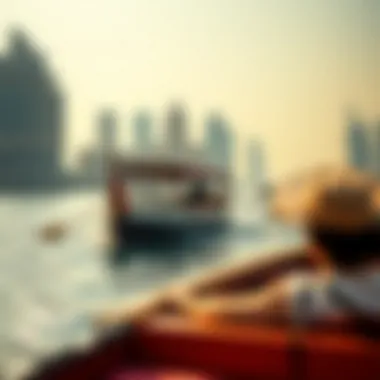

The Historical Context of the Abra Boat Service is vital in understanding its role in Dubai's evolving identity and infrastructure. It reflects not only the practical transportation needs of the city’s inhabitants but also the cultural significance that the service embodies. When one considers how the Abra navigates the waterways, it's not just about crossing the water; it's about connecting the past with the present. This section aims to peel back the layers of history, offering insights into how this mode of transport has shaped, and continues to shape, the socio-economic landscape of Dubai.
Origins of the Abra
The concept of the Abra is deeply rooted in the traditions of the region. The earliest forms of these wooden boats can be traced back to Dubai’s maritime past, a time when trade and fishing defined the livelihood of many local communities. These wooden vessels were meticulously crafted from traditional materials like wood, employing techniques passed down through generations. The first Abras served as simple ferries, shuttling people across the Dubai Creek and linking various sides of the city that remained divided by water.
"Exploration of the Abra’s origins reveals its quintessential role in nurturing community ties and promoting economic exchanges from as early as the mid-20th century.”
The riverbanks flourished with souks and marketplaces, where traders exchanged goods such as spices and textiles. The Abra became almost a lifeline amid these bustling commercial activities. For instance, a fisherman could sell his fresh catch at the wholesale market on one side, while buyers could easily reach the other side through this serene boat service. This symbiotic relationship between the Abra and the local economy laid the groundwork for what would later evolve into Dubai's global trading hub.
Evolution Over Time
As Dubai progressed through economic booms and expansions, the Abra service saw its own transformations. Initially, the fleet was entirely traditional, powered by manual rowing. As modern transportation options emerged, the significant upgrade in 2000s began to shape the future of the Abras. Today, while many traditional Abras still glide across the creek, there are also modern variations that offer a more luxurious experience. These newer vessels are often equipped with engines, making them quicker and more efficient, catering to a growing tourist demographic.
Additionally, the routes have expanded significantly, reflecting the city’s growth. What once was a simple crossing between Al Seef and Deira has evolved into a network serving several neighborhoods, accommodating the needs of residents and tourists alike. Furthermore, contemporary challenges such as safety regulations and the integration of eco-friendly practices are reshaping the Abras once again. This constant adaptation highlights that the Abra is not merely a mode of transportation but a vital component of Dubai’s ever-changing identity and an integral part of its cultural heritage.
In essence, as we explore this historical tapestry, it becomes clear that the Abra service is much more than an efficient way to traverse water; it is a testament to Dubai's rich history, a bridge connecting various communities, and an essential thread woven into the fabric of the city's urban narrative.
Operational Mechanics
The operational mechanics of the Abra Boat Service serve as the backbone of its functionality in Dubai's bustling waterway network. Understanding its framework is crucial for grasping how this service integrates with the city’s overall transport system and the cultural significance it holds. The efficiency and reliability of such operations not only benefit locals but also enhance the experience for tourists and investors alike.
Types of Abras
Traditional Abras
Traditional Abras present a glimpse into Dubai's maritime heritage. These wooden boats, often handcrafted, boast a unique charm. Their primary characteristic lies in their simplicity—powered by outboard motors, they glide effortlessly across the Deira Creek and Dubai Creek. One distinctive feature of Traditional Abras is their open-air design, which allows passengers to feel the wind and sun as they traverse the waters.
What makes Traditional Abras a popular choice is their affordability; they usually have a low fare, making them accessible for anyone looking to cross the creek. However, their lack of modern amenities can be a disadvantage, particularly during the sweltering summer months when air-conditioned comfort is a preferred option. Nevertheless, choosing a Traditional Abra is not merely a trip; it’s an experience steeped in history—an essential aspect of the overall topic.
Modern Abras
In contrast, Modern Abras have been engineered to cater to today’s urban demands while retaining the aesthetic delights of their traditional counterparts. These boats often come equipped with comfortable seating and enclosed spaces, making them an appealing choice for tourists and locals alike. The key characteristic of Modern Abras is their ability to combine convenience with comfort, offering a more pleasant journey across the waterways of Dubai.
A unique feature of Modern Abras is their potential for private charters. This opens avenues for group trips or special occasions, enhancing their versatility. The downside? The fares tend to be higher than that of Traditional Abras. Yet, the blend of modern functionality with a nod to tradition resonates well with a broad audience, embedding these vessels into the broader topic of Dubai's water transport landscape.
Routes and Schedules
The routes and schedules of the Abra services are as dynamic as the city itself. Operating mainly between Bastakiya and the Dubai Deira, the boat routes cater to both residents commuting to work and tourists eager to soak in the views.
Service usually runs from early morning until late at night, making it a reliable option for those needing to cross the waterway. The frequency of the boats can vary, with buses and other transport hubs closely connected to the Abras, ensuring seamless transitions. Moreover, an awareness of these schedules can greatly enhance an investor's appreciation for property values nearby.
To sum up, understanding the operational mechanics is fundamental for anyone looking to navigate the Abra Boat Service effectively. Whether one opts for a traditional boat or a modern variant, and regardless of the intended route, awareness of the system backed by operational mechanics is vital to truly appreciate this distinctive element of Dubai's urban fabric.
Economic Impact
The Abra Boat Service serves as more than just a transportation option in Dubai; it pulses through the city's economic veins. It connects various neighborhoods, making it a vital cog in the wheel of commerce, tourism, and social interactions. Understanding the economic implications of this service provides clarity on why it is an essential component for investors and local businesses alike.
Tourism Contributions
Tourism is one of the driving forces behind Dubai's booming economy, and the Abra Boat Service plays a significant role in that landscape. Every year, millions of tourists flock to the city, eager to experience its unique blend of modernity and tradition. But, why do they choose the abra?
- Cultural Experience: For many visitors, riding an abra isn’t merely about crossing the water; it's about indulging in the local culture. The serene navigation along the historic Dubai Creek presents a picturesque scene, often described as the heart of the city. Tourists revel in the chance to be part of this lived experience, often choosing it over modern alternatives.
- Accessibility and Affordability: The cost-effective fare of the abra makes it an attractive option for tourists who wish to explore without breaking the bank. This accessibility encourages more foot traffic to nearby shops and attractions, optimizing the tourist spend.
- Engagement with Local Economy: When tourists use the abra service, they indirectly support local businesses that thrive along the waterways. Simple activities like purchasing traditional crafts or dining at local eateries near the docking points contribute substantially to the economic ecosystem.
"More than just transportation, the Abra connects lives, cultures, and economies."
These factors highlight the role of the abra in boosting tourism revenues, making it indispensable in shaping Dubai’s economic narrative.
Support for Local Businesses
Not only does the Abra Boat Service contribute directly to the tourism sector, but it also plays a pivotal role in supporting local enterprises. The presence of the abra enhances community vibrancy, especially around docking stations—often regarded as commercial hubs.
- Foot Traffic Influx: Areas surrounding abra stations have seen an increase in foot traffic. This spike benefits assorted local businesses, from artisanal markets to small cafes. Higher pedestrian activity translates to increased sales for these establishments, forging a symbiotic relationship.
- Job Creation: The demand for services related to the abra has led to job creation. Beyond the boat operators, various support roles arise, from transit coordinators to vendors selling local wares. Each role reinforces the local economy, ensuring that the benefits of tourism trickle down to residents.
- Community Identity: The abra serves as a cultural anchor, fostering a sense of community among local businesses. Collaboration between vendors and operators often results in unique offerings, like abra-themed souvenirs or guided tours, showcasing the rich history tied to these boats.
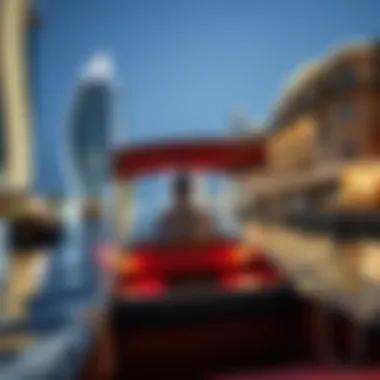
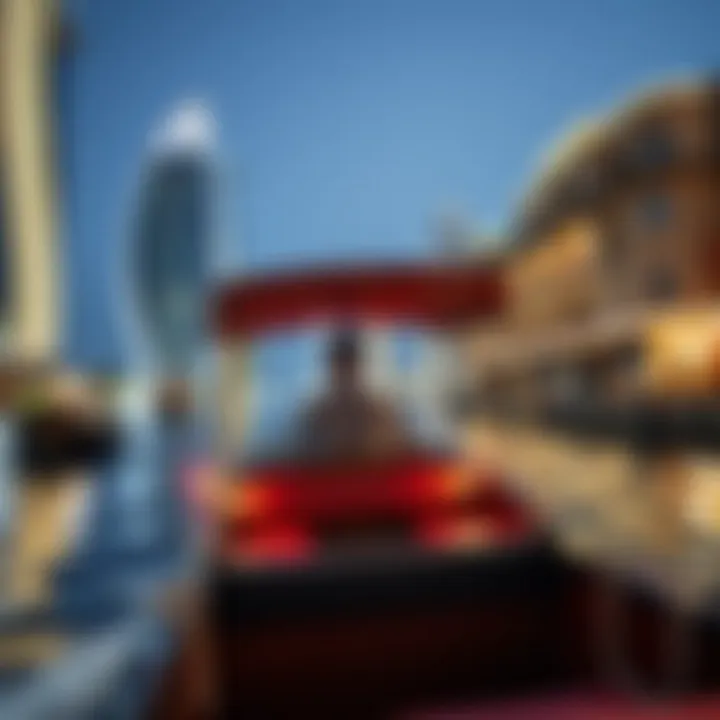
In summary, the economic impact of the Abra Boat Service extends far beyond mere transport options. It fosters tourism, supports local businesses, and ultimately strengthens the city’s economic fabric. For those considering investment or involvement in Dubai’s real estate scene, recognizing the nuanced interplay of the abra with the local economy is crucial for informed decisions.
Cultural Significance
The Abra Boat Service is more than just a form of transportation; it's a living embodiment of Dubai's rich cultural heritage. Through its undulating passages on the waterways, the Abras narrate stories of old, echoing the traditions of a city that has merged its past with the vibrancy of modernity.
Embodying Tradition
To understand the true value of the Abra in Dubai, one must recognize its deep-rooted connections to the emirate’s history. The Abra service finds its origins in the early days when people relied on waterways for trade and travel. It stands as a testament to the simplicity and effectiveness of maritime transport that existed well before the construction of towering bridges and extensive roads.
These wooden boats, crafted meticulously by skilled artisans, are often seen anchored along the creeks. They hark back to a time when life revolved around water, offering not just a means to cross but a reminder of Dubai's humble beginnings. Each ride aboard an Abra stimulates a connection to the past, allowing passengers to traverse the very routes that local traders once used. It's more than a boat ride; it's a journey into tradition, carried forward into the bustle of the present.
Many locals view the Abra as a symbol of community. The wooden vessels often see families traveling together, sharing stories, and passing down wisdom as they glide across the water.
Within this cultural network, the abras represent unity; they connect neighborhoods and foster interactions that whitewashed walls of high-rises seldom encourage.
Art and Architecture of Abras
The Abras themselves are a symbol of Dubai's artistic prowess and architectural ingenuity. Traditional Abras are characterized by their simple yet functional design, usually made from wood, with a flat bottom that allows for easy navigation in shallow waters.
From afar, the Abras might seem plain, but their elegance shines brighter when viewed up close. The craftsmanship involved in constructing these boats is an art in itself. The intricate designs on the hulls and the rustic touch of the wooden steering mechanisms provide a rustic charm that most modern vessels lack. Tall, proud, and often beautifully adorned, they flaunt a traditional aesthetic.
"Every Abra is like a canvas, reflecting both the mind of its maker and the spirit of its time.”
Their architecture balances form and function, demonstrating a deep understanding of marine engineering without the frills seen in contemporary designs. It's fascinating to note how these boats have adapted while still retaining their original charm, incorporating modern technologies such as sturdy motors while remaining true to their artisanal roots.
In spaces like the Dubai Water Canal, Abras serve not only their navigational purpose but also stand as art pieces themselves, celebrated by both residents and tourists alike. They often feature prominently in local markets, participating in festivals, and highlighting Dubai's commitment to preserving its culture amidst rapid urban development.
With time, the Abra’s influence expands beyond just its functional use; it promotes an appreciation for craftsmanship that is crucial in a fast-moving world. For real estate investors and property managers, the presence of these boats signifies areas rich in cultural intimacy, appealing to those looking to merge lifestyle choices with community experience.
By understanding the historical and artistic value of the Abra, one appreciates its crucial role in Dubai's identity—an experience enriched by every ride, linking the past to the present, while enticing future generations to cherish their roots.
Real Estate Context
The Abra Boat Service in Dubai, while primarily a mode of transportation, has far-reaching implications in the realm of real estate. Understanding its influence is crucial for investors, homebuyers, and property managers. Not just a picturesque method to cross the water, these traditional vessels connect diverse neighborhoods, fostering both economic activity and social interactions. This synergy between transportation and real estate adds layers of value to properties situated along the waterways.
Impact on Neighborhood Dynamics
The Abra service impacts neighborhood dynamics in various ways. It serves as a connector, linking communities that may otherwise feel isolated due to geographical barriers. For instance, areas like Deira and Bur Dubai, which are separated by Dubai Creek, benefit immensely from the ease of access provided by these boats. This connection nurtures a vibrant local atmosphere, drawing frequent visitors and residents alike.
- Increased Interactions: As residents from different areas interact, there's a noticeable cultural exchange. Local markets thrive as shoppers use the service to explore shops on either side of the creek.
- Boosting Local Economies: Businesses near the abra stations often see a rise in foot traffic. Coffee shops, restaurants, and small retailers benefit by catering to both commuters and tourists, enhancing their visibility and sales potential.
It’s evident that the abra is not merely a transit service—it’s a lifeline that strengthens the fabric of community life, making neighborhoods more attractive to potential residents.
Property Values Near Waterways
Properties that boast proximity to these waterways typically command a premium. Homes and commercial spaces situated within walking distance of abra stations tend to appreciate more rapidly than those located farther inland.
This trend can be attributed to several factors:
- Desirability: Living near water not only offers aesthetic benefits but also provides a unique lifestyle that many find appealing. The bustling scenes of the creek, coupled with the ease of transport, draw buyers looking for vibrant urban living.
- Investment Potential: Investors understand that properties near such an essential transportation service remain in demand. The consistent flow of people bolsters rental income prospects, making such properties attractive long-term investments.
- Development Opportunities: Areas adjacent to popular abra routes are often targeted for development projects. These developments include luxury apartments, shopping centers, and leisure facilities, further propelling property values.
"In Dubai, the proximity to water isn't just a charm—it's a strategic advantage that can dictate market trends and investment success."
In summary, the Abra Boat Service intricately weaves into Dubai's real estate narrative. Its impact on neighborhood dynamics and property values makes understanding this linkage vital for stakeholders across the board. Being informed means being prepared to seize opportunities as they arise in this ever-evolving market.
Sustainability Considerations
In today's age, sustainability is not just a buzzword tossed around in meetings. It's a critical framework through which businesses and services must operate to meet the needs of the present without compromising the ability of future generations to meet theirs. The Abra Boat Service in Dubai stands at a crucial intersection of transportation, culture, and environmental responsibility. Understanding its sustainability considerations is vital for anyone navigating through its waters, especially investors and property managers, who play a significant role in shaping the future of the city's landscape.
Environmental Impact
The Abra, with its wooden structure and simplistic design, is often seen as a relic of the past. However, it is also an environmentally friendly mode of transportation. The traditional abras are powered by diesel engines, which do create emissions; yet, they consume less fuel compared to larger vessels due to their size and weight. This has implications not just for the waterways but also for public health and air quality in the surrounding urban areas.
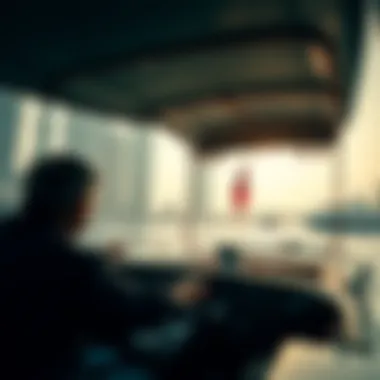

Consider this:
- Reduced Carbon Footprint: A large portion of Dubai’s transit relies on fossil fuels, which can negatively influence the region’s air quality. In this respect, the Abra poses as an alternative that mitigates carbon output to a degree, especially when used in tandem with other sustainable modes of transportation.
- Water Quality Preservation: The usage of abras helps to ease congestion on bridges and roads, indirectly preserving the waterways. This matters because cleaner waterways are fundamental not just for the marine ecosystem but for maintaining the cultural heritage represented by these waterways.
- Wildlife Corridors: Abras navigate through crucial habitats for a range of aquatic species, playing a role in the conservation of marine life. Their minimal disruption to these ecosystems can be a refreshing aspect when compared to motorized larger craft.
"With the right balance and a focus on sustainability, the Abra can transform from a simple public transport service into a beacon of eco-friendliness."
Future Sustainability Initiatives
Looking toward the horizon, there is ample room for improvement and evolution within the Abra Boat Service. Several innovative strategies and initiatives can ensure that it keeps pace with modern demands for sustainability:
- Hybrid or Electric Abras: The introduction of hybrid models could revolutionize the service. By reducing dependence on diesel, the abras could operate in a much cleaner manner. Imagine a fleet of silent, electric-powered abras gliding across the waters, free of emissions and noise.
- Community Engagement Programs: Inviting local communities to engage in eco-friendly initiatives can foster a greater sense of ownership and responsibility towards the waterways. For instance, setting up clean-up days could directly involve residents in preserving their environment while promoting tourism.
- Regular Environmental Assessments: Implementing systematic assessments related to environmental impacts could facilitate informed decision-making. Regular reports on water quality, emissions, and ecological health can help position the Abra service as a leader in sustainable transit.
As Dubai continues to grow, the integration of sustainability in the Abra Boat Service not only reflects a commitment to the planet but also reinforces the vibrant culture and heritage embedded in this unique mode of transportation. It offers a tangible way to marry tradition with modern sustainability practices, ensuring future generations can continue sailing these waters.
Challenges and Limitations
While the Abra Boat Service is a noteworthy element of Dubai's transport infrastructure, it is crucial to acknowledge the challenges and limitations that come along with it. These factors must be carefully navigated by any potential investor, homebuyer, or property manager looking to understand the true encapsulation of this service within the dynamics of the community.
Safety Concerns
One of the foremost considerations of the Abra Boat Service pertains to safety. Incidents on the water can happen, often due to a lack of adequate safety measures or oversight. It’s important to understand that while riding an abra can offer a picturesque view of the waterways, the safety protocols may not always be stringent.
- Lifesaving Equipment: Many abras are equipped with life jackets, but their availability can fluctuate by specific routes or operators. It's common for passengers to find themselves without sufficient safety gear.
- Operator Training: The experience and training of the boat operators can differ significantly. Not all operators go through the same rigorous training, which can lead to varying levels of competency when it comes to navigating the waters safely.
- Weather Conditions: Dubai's weather can get quite harsh, particularly during the summer months. High winds and turbulent waters could pose risks, making it essential for passengers to remain observant of weather updates before embarking on their ride.
Understanding these safety measures is not just about personal safety; it directly impacts the broader scope of the service's reputation and reliability. For investors, potential accidents could lead to decreased demand and subsequently impact property values in waterfront communities.
Capacity and Demand Issues
The supply-demand equation plays a crucial role in the effectiveness and efficiency of the Abra Boat Service.
- Overcrowding: Depending on the time of day, certain routes can become exceedingly crowded, leading to long waits and a chaotic boarding process. This discomfort can deter tourists and locals alike from opting for the abra. In terms of real estate, areas near these routes may experience fluctuations in desirability based on this accessibility.
- Peak Times: During peak tourist seasons, the influx of visitors can exceed the service’s capacity. Abras have limited seating, and during popular times, the limited availability might push potential riders towards alternative modes of transport, affecting the overall utility of this service.
- Adaptability: There's a growing demand for more modern, faster options in water transport. Should the service fail to innovate or adapt to changing preferences, it may fall behind in favor of more contemporary alternatives that align better with the city’s rapid development and its residents' expectations.
Addressing these demand-related limitations means looking at how to enhance the operation of the service while maintaining its traditional charm. For those investing in surrounding areas, it's crucial to keep a finger on the pulse of demand trends and adapt strategies accordingly.
Understanding both safety and capacity concerns reveals the intricate web of considerations that underpin the Abra Boat Service. By being perspicacious about these limiting factors, stakeholders can position themselves more favorably in the landscape of Dubai’s evolving transport and real estate sectors.
Future Prospects
The future of the Abra Boat Service in Dubai looks promising and full of potential. As the city evolves, so does its transportation infrastructure, and the Abra plays an essential role in this transformation. Investors, homebuyers, and property managers should pay close attention to how the service aligns with the broader trends of urbanization and technological innovations. The Abra is not just a mode of transport; it's a symbol of continual adaptation, and its prospects are intertwined with the growth of Dubai itself.
Technological Advancements
The integration of technology into the Abra service is on the horizon. Consider the concept of smart boats. Imagine Abras equipped with GPS tracking and integrated scheduling systems. This could enhance the user experience by providing real-time updates to passengers about wait times and routing options. Such technological improvements may also lead to better fuel efficiency, aligning the service with sustainability goals.
Moreover, mobile apps catering to Abra services could allow users to book rides, much like popular ride-sharing platforms. How easy would it be to hop on a boat without standing in line? This seamless collaboration between technology and transportation could cement the Abra’s status in the competitive transport sector.
"Embracing technology is not a choice; it's becoming a necessity for modern transport services to stay relevant in the ever-evolving urban landscape."
Integration with Urban Development
The Abra service fits neatly into the narrative of Dubai’s urban development plans. As new neighborhoods sprout near waterways, the need for quick and efficient transport options becomes essential. Urban planners are increasingly seeing Abras as a viable link between the existing passenger transport networks and the expanding infrastructural spine of Dubai.
For example, as property developments like Dubai Creek Harbour come online, Abras could facilitate easier access for residents and visitors. These boats can provide scenic travel routes while minimizing road congestion and traffic-related woes.
Also, further integration of the Abra service with the Metro system or tram lines could make it a vital cog in Dubai's transportation wheel.
Closure
The importance of summarizing the Abra Boat Service cannot be overstated. As we navigated through the multifaceted role of this iconic water transport, several key elements emerged that underline its significance in Dubai’s landscape.
Recap of Key Points
- Historical Context: We traced the Abra’s origins and its evolution, showing how a simple mode of transport transformed into a cultural symbol.
- Operational Dynamics: An understanding of the different types of Abras and their routes is crucial for anyone wishing to utilize this service.
- Economic Contributions: The economic impact represents a dual benefit: it supports local tourism while also bolstering small businesses along the waterways.
- Cultural Significance: The Abra epitomizes the heart of Dubai's traditions, with its unique designs and artistry available for all to see.
- Real Estate Implications: Proximity to these waterways affects property values and neighborhood dynamics, making it a pertinent aspect for investors to consider.
- Sustainability and Challenges: We evaluated both the sustainability initiatives that are underway and the challenges facing the service, such as safety and capacity concerns.
Through this lens, we see how the Abra is not just a mode of transport; it encompasses history, culture, and economic vitality, making it a key player in Dubai's ongoing development.
Final Thoughts on the Abra's Role
Investing in properties near Abra routes, understanding the local market dynamics, or simply appreciating its cultural significance enrich the overall experience of living or visiting Dubai. The future for the Abra looks promising, fostering a blend of progress while remaining true to its roots.















